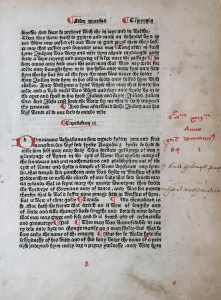New Acquisition: Leaf Printed by William Caxton, 1482
Special Collections and University Archives is pleased to announce the recent acquisition of an incunabula leaf from the Polychronicon printed by William Caxton (c. 1422-1491), the English printer who notably brought the first printing press to England in 1476.

This leaf contains text from chapter 12 of book 4 of the Polychronicon, which recounts history during the life of the Roman Emperor Domitian. The leaf measures 11 x 8.25” and the text is composed of 40 lines in Gothic type with red rubrics and paragraph flourishes. The leaf also includes marginal annotations in a contemporary hand. Caxton’s printed leaf supports research in the material history of the book and printing in the West and joins other examples of early printing available in the rare book collection.

